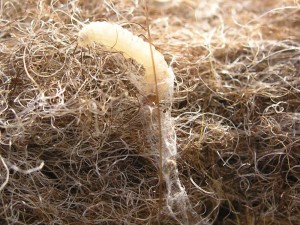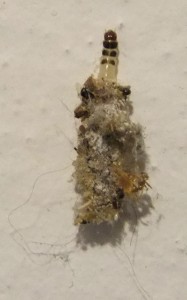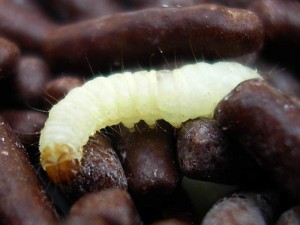Moth larvae are very small - especially in the period from hatching to adulthood, but as adults they are easy to spot.
The size of full-grown larvae varies from species to species and can be between 6 and 20 mm. However, most larvae are between 7 and 13 mm in length.
The larvae are whitish or yellowish with dark heads. They are often found on textiles or in food.
Below are pictures of a clothes moth caterpillar, a fur moth caterpillar and a two-colored seed moth caterpillar. There is no picture of a seed moth caterpillar, but it is very similar to the two-colored seed moth caterpillar.
Size, food, habitat and characteristics
The table below shows the size, food, habitat and characteristics of moth larvae:
| Moth species | Image of the adult moth | Length of the fully developed caterpillar | Food | Typical habitats | Characteristics |
| Clothes moth | 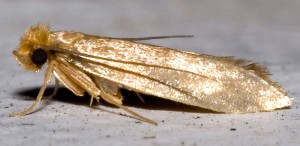 |
8 - 10 mm (usually) but up to 13 mm | Wool, silk, feathers and down, but also mixed textiles and impure textiles. | Textiles (especially clothing) in cupboards, drawers, bags, boxes, etc. and home textiles. | The caterpillar spins its pupa directly on the food source and feeds on it from there. The pupa consists of webs, excrement and parts of the food source. |
| Fur moth | 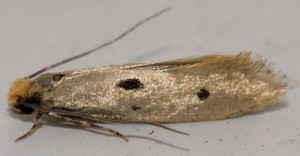 |
6 - 9 mm (in its cocoon) | Especially fur and feathers, but also other textiles and possibly some dry foods. | Textiles in cabinets, drawers, bags, boxes, etc. as well as home textiles and to some extent kitchen cabinets. | In the pupal stage, the caterpillar drags its pupa with it and tends to move upwards - for example, it settles on the ceiling or walls. The pupa is the same color as the food source. |
| Frog moth | 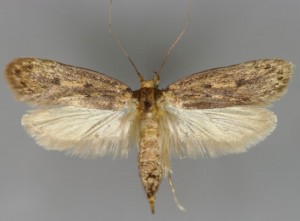 |
6 - 20 mm | Textiles, dry food, plant materials and certain animal materials. | Wardrobes, kitchen cabinets, utility rooms, garages, basements, attics, gardens and more. | The caterpillar is almost omnivorous, but in homes they often feed on organic materials such as textiles and food - often found in bird nests. |
| Two-colored seed moth | 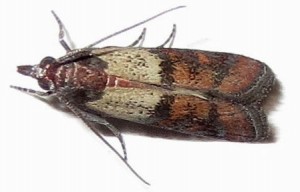 |
12 - 13 mm | Dry food and certain plant materials. | Kitchen cabinets and other places where dry food is stored. | Hiding in food or in dark crevices, cracks, corners, etc. around food. |
Moth larvae in clothes
As shown in the table above, larvae in clothing can be one of the following moth species:
- Clothes moth (very likely)
- Fur moth (likely)
- Seed moth (less likely)
Moth larvae most commonly attack clothing made of organic materials such as wool, silk, fur, feathers, etc. In addition, clothes moths can also attack clothes made of synthetic or plant materials such as cotton, linen, hemp, etc.
Signs of moth presence in clothing include:
- Small holes in your clothes
- Spiders on your clothes
- Excrement on your clothes
- Caterpillars crawling around on or in clothes
If you notice moth larvae in clothing or other textiles, it will most often be clothes moths, while larvae in fur will typically be fur moth larvae. All moths prefer clothes that are tucked away in closets, drawers, bags, etc. that are rarely used.
Moth larvae in food
Moth larvae in food can be one of the following moth species:
- Two-colored seed moths (very likely)
- Seed moth (likely)
- Fur moth (less likely)
Moth larvae usually attack dried foods such as cereals, grains, seeds, semolina, bulgur, rice, dry milk, instant coffee, etc. but can also attack tea, spices, tobacco, etc. Signs of moth presence in food include:
- Spider webs on food
- Excrement on food
- Caterpillars crawling on or in food
- Food looks lumpy, strange or spoiled
When moth larvae infest food, they will eventually begin to crawl towards the surface of the food and become visible, so you should check all dry food in your kitchen cabinets if you suspect moths.
Combat
Fight against clothes moth as well as food moths is about killing and removing all eggs, larvae and adult moths.
For clothing mills, this can be done in 4 ways:
- Washing and drying
- Dry cleaning
- Freezing (below -18° for at least 2 days)
- Heating (above 50° for a minimum of 30 minutes)
In addition, berries use moth bags and clothes moth traps (they also work against fur moths):
For food moths, control should consist of thorough cleaning and disposal of all infested food. You may be able to freeze or reheat foods where damage is minimal.
Remember, it's always important to find out where food moths come from; it could be the store, warehouse, manufacturer, neighbor or your own home! Food moths should always be controlled where they originate.
In addition, you should use flour moth traps (they work against all food moths):
In theory, you can also control moths with insecticides, but this is not recommended in most cases. It is only appropriate for very heavy infestations and should always be done in collaboration with a licensed pest control company.
Prevention
The best way to prevent future infestations of clothes moths is to
- Storage: Store all infrequently used clothing and textiles in fully sealed plastic or paper bags (especially clothing and textiles made from organic materials)
- Moth bags and moth traps: Hanging or inlaying moth bags in all cupboards and drawers containing clothes or other textiles (especially clothes and textiles made of organic materials. For clothes moth prevention, we recommend moth bags and clothes moth traps (they also work against fur moths, and for food moth prevention, we recommend flour moth traps:
You can also read more about moth control and prevention in the respective articles for each species:
You'll also find a overview of 12 different moth species here.

